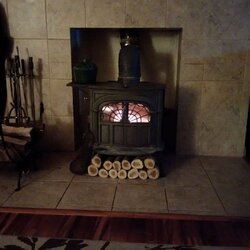TOP TIP - Stretching Your Firewood Supply
Every year I learn something new. (Well, I guess I can even try for every hour of every day!) But with respect to wood heat I can usually pass along one or two new useful tips every season.
This is a really good one...
How do you stretch your firewood supply and at the same time maintain a truly comfortable temperature? (as opposed to GOD I FEEL LIKE I'M ON A SHIP IN CLOSE ORBIT AROUND THE SUN )
)
Here it is:
Gather and save MUCH MORE dry kindling than you think you need. And use it several times a day.
If you're like me, not all of your wood is perfectly seasoned. Which means, you might not always have a small enough, and dry enough split on hand that will catch if you let the embers get really low. So what do we do? We STOKE When the stove has red hot coals, we stoke. It's a GUARANTEE that there will be no headaches starting the new load.
When the stove has red hot coals, we stoke. It's a GUARANTEE that there will be no headaches starting the new load.
But with a cast iron (or soapstone) stove, that's not always necessary. Unless the room is unGodly cold, I let my VC Intrepid burn down to where I can barely see a glow thru the glass. The room and 1st level of the house is still comfortable, especially if the stove has been going for a few hours. I keep kindling indoors, at the ready. To start the initial fire in a cold stove, I go with a bunch big enough that I need two hands to hold it.
But when I restart, I can use less. I toss that on the dying ember, maybe even with some paper, then a few small splits and broken pieces, and in no time there's a fire again and my splits are becoming involved. Without the kindling, even if I have cardboard, it can be much more of a hit and miss deal. As I said, my wood is not always perfectly seasoned. If your splits are really dry, you can probably get away without using kindling and get them going with only cardboard and paper. But dry twigs provide the extra BTU's needed to get slightly under-seasoned wood to catch.
So gather your kindling, and keep a lot handy. Instead of stoking when your stove is still really hot, let the heat life of the material work for you. Catch the coals during their last gasp. As long as the firebox is warm and you have twigs, you will get a roar going again directly.
Every year I learn something new. (Well, I guess I can even try for every hour of every day!) But with respect to wood heat I can usually pass along one or two new useful tips every season.
This is a really good one...
How do you stretch your firewood supply and at the same time maintain a truly comfortable temperature? (as opposed to GOD I FEEL LIKE I'M ON A SHIP IN CLOSE ORBIT AROUND THE SUN
 )
)Here it is:
Gather and save MUCH MORE dry kindling than you think you need. And use it several times a day.
If you're like me, not all of your wood is perfectly seasoned. Which means, you might not always have a small enough, and dry enough split on hand that will catch if you let the embers get really low. So what do we do? We STOKE
 When the stove has red hot coals, we stoke. It's a GUARANTEE that there will be no headaches starting the new load.
When the stove has red hot coals, we stoke. It's a GUARANTEE that there will be no headaches starting the new load.But with a cast iron (or soapstone) stove, that's not always necessary. Unless the room is unGodly cold, I let my VC Intrepid burn down to where I can barely see a glow thru the glass. The room and 1st level of the house is still comfortable, especially if the stove has been going for a few hours. I keep kindling indoors, at the ready. To start the initial fire in a cold stove, I go with a bunch big enough that I need two hands to hold it.
But when I restart, I can use less. I toss that on the dying ember, maybe even with some paper, then a few small splits and broken pieces, and in no time there's a fire again and my splits are becoming involved. Without the kindling, even if I have cardboard, it can be much more of a hit and miss deal. As I said, my wood is not always perfectly seasoned. If your splits are really dry, you can probably get away without using kindling and get them going with only cardboard and paper. But dry twigs provide the extra BTU's needed to get slightly under-seasoned wood to catch.
So gather your kindling, and keep a lot handy. Instead of stoking when your stove is still really hot, let the heat life of the material work for you. Catch the coals during their last gasp. As long as the firebox is warm and you have twigs, you will get a roar going again directly.



